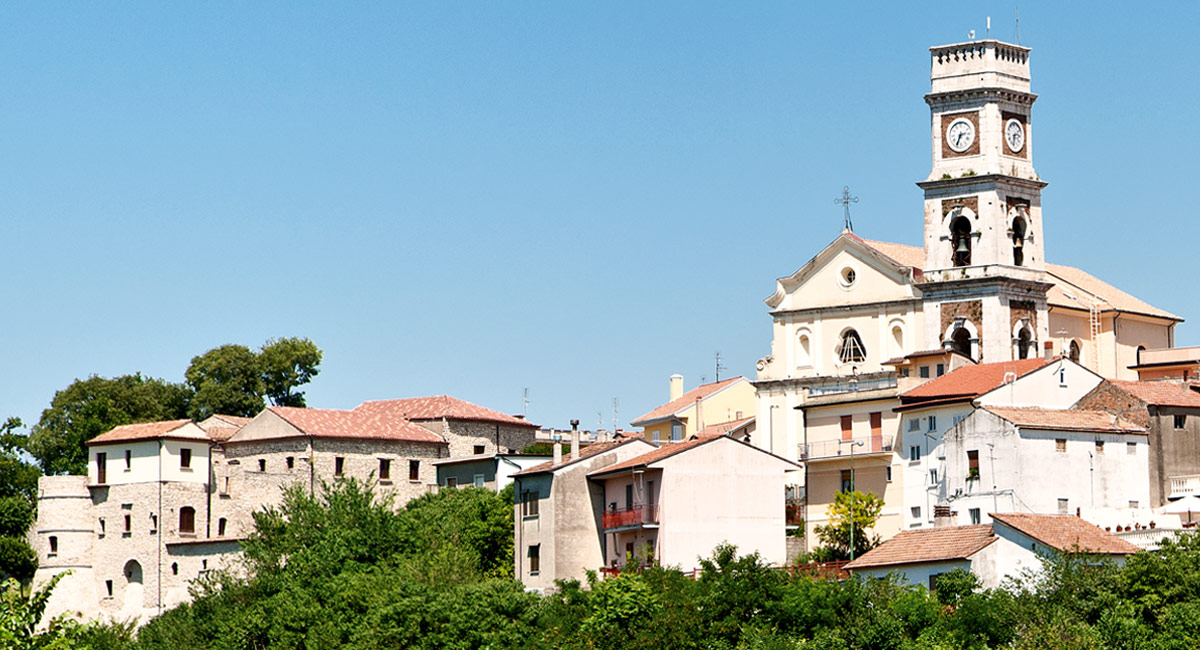ITINERARIES IN THE VALLEYS OF GOOD LIVINGGrottaminarda

Located at the entrance to the middle Ufita Valley, on the edge of the Catauro and Tanauro hills, the town of Grottaminarda lies along a major road junction, which since ancient times has provided access from the Tyrrhenian to the Adriatic, initially via the Appian Way and later via the Puglia National Road. Numerous archaeological discoveries have been made in its territory, attesting to human habitation since prehistoric times. In Roman times, the area fell under the jurisdiction of the nearby colony of Aeclanum (present-day Passo di Mirabella). Discoveries of architectural clay, funerary and celebratory inscriptions, and rural settlements have been made in various locations within the municipality, especially on the hills of Sant'Andrea di Carpignano, in Bosco, and in the Ruvitiello district near the Ufita River. The toponym appears to be a compound of grotta (grotto) and a second term, Mainarda or Minarda, whose meaning remains uncertain to this day, although some scholars, such as Carla Marcato, hypothesize a derivation from the Germanic personal name Maynardus. The town is first mentioned as Cripta in a deed dated 991, while the specification Minarda appears in documents drawn up at the beginning of the 13th century. Among the first lords to be invested with the fiefdom, documents mention Trogisio, a Norman knight who arrived in the retinue of Robert Guiscard. Soon, however, the town became part of the possessions of the powerful d'Aquino family, to whose lineage it belonged from 1134 to 1531 through the succession of noble ancestors and descendants of Saint Thomas Aquinas, son of Andrea, feudal lord of Grottaminarda from 1244 to 1259. Ladislaus II of Aquino's aversion to the Spanish led to the loss of the fiefdom taken from the family by Charles V at the end of the war between France and Spain. In 1532, the town was assigned to the French de Rupt family, from whom it subsequently passed to the Loffredos. At the end of the 16th century, the Cosso family, dukes of Sant'Agata dei Goti, purchased the feudal property, which in 1627 passed into the hands of Fulvio della Cornea, who died shortly thereafter without leaving direct heirs, thus passing the territory under the direct jurisdiction of the Royal Treasury. The history of the 17th century begins with the popular uprisings led by Masaniello: the people of Grotte participated in the siege of nearby Ariano, where many of the Irpinia feudal lords had taken refuge. After four days of fighting, the town was conquered and many lords were executed. The revolt was repressed a few months later, both with the support of those responsible for the popular uprisings and with harsh fiscal repression that brought the already weak economic condition of the area to its knees. It contributed to the worsening of the plague that broke out in 1656: over a thousand deaths were due to the terrible contagion. In the following decade, also as a result of the desperation caused by a strong demand for taxes by the Spanish government, several armed groups of brigands established their headquarters in the countryside of Grottaminarda: the bandits specialized in kidnapping along the road that led from Naples to Puglia. In 1698 the fiefdom was sold by the treasury to the Della Porta family. The last lords of the place until the year of the abolition of feudal rights (1806) were Baldassarre and Raffaele Coscia di Paduli.
ITINERARIES IN THE VALLEYS OF GOOD LIVINGPlaces of Interest
Church of Santa Maria Maggiore
A few meters from the castle is the monumental Church of Santa Maria Maggiore, first built in 1478, rebuilt in the second half of the 18th century, and restored in 1995. The façade is particularly impressive, with an ornate Baroque stone portal, a broken triangular pediment, a large bell-shaped window with two side niches, and an oculus above. The interior, with a single nave and several side chapels, houses numerous works of art. These include a painting depicting Saints Thomas and James venerating the Blessed Sacrament by Antonio Sarnelli, a fresco on the nave vault depicting the Assumption, executed in 1768 by Matte Vigilante, a precious painting on wood from 1573 with the Madonna of the Rosary, silver monstrances from the mid-18th century, a Neapolitan school chalice from 1833, a pipe organ from the second half of the 18th century, and the marble baptistery. Next to the building is the bell tower, built between 1766 and 1772 to a design by Vanvitelli. Above the entrance leading to the tower, which rises on four levels and still features the original spiral stone staircase, are parts of the marble funerary monument created in the first half of the 17th century by Francesco Vannelli and depicting the archpriest Giovanni De Bellucis.
Sanctuary of Carpignano
A popular place of worship is the Sanctuary of Carpignano, built on the site of an ancient chapel of the Teutonic Order. The single-nave church has a simple gabled façade flanked by a five-story bell tower with a town clock. Inside the temple is a precious panel painting depicting the Virgin and Child, perhaps dating back to the mid-12th century. Adjacent to the church is the Mercedarian Convent, built in the early 20th century. The entrance to the church is preceded by a well-preserved Roman marble statue from the excavations of ancient Aeclanum.
Aquino Castle
The old town center, encompassed by the current Fratta district and Via Minichiello, Corso Vittorio Emanuele, and Via Cancello, is dominated by the Castello d'Aquino, now owned by the municipality. The fortress, whose original layout most likely dates back to the early Middle Ages, was expanded around the 11th century, when a defensive wall was also built around the town. The building still displays some traces of the ancient curtain wall, constructed in opus listatum with external facings composed of alternating rows of bricks and river pebbles, bonded without the aid of cement mortar. A cylindrical tower and a square tower, approximately 14 meters high and just over 10 meters in diameter, stand at the corners of the western side of the castle, while two other towers of the same size, the first cylindrical and the second hexagonal, are visible on the façade facing the old town center. Both in the towers and in the intervening curtain walls, in some sections with evident battlements and base buttresses, walkways and evocative underground passages are still preserved.
Church of St. Michael the Archangel
The Church of San Michele Arcangelo is among the oldest in the area, having been mentioned in documents dating back to 1178. The façade is a simple gabled structure with a stone portal dating back to 1541. Inside, a single-nave church houses an 18th-century wooden statue depicting Saint Michael slaying the devil. Also noteworthy is the Church of San Tommaso, on Via Cancello, which houses a 17th-century copper and silver bust of the saint and a precious silver reliquary from 1794.

